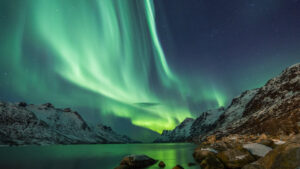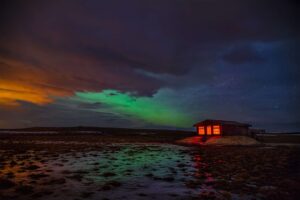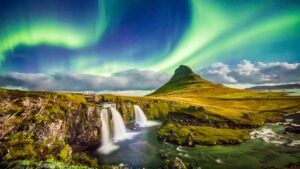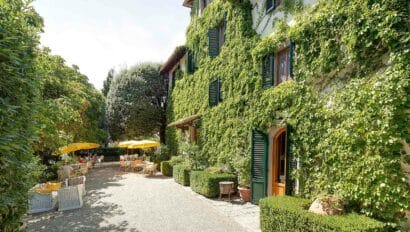When solar winds collide into our atmosphere, layers of gases combine with particles carried in the winds to reveal a dance of chemistry that creates the Aurora Borealis, the northern lights. Greens and pinks shimmer as layers of oxygen and nitrogen become illuminated in a way that only a natural phenomenon could display—until now.
Kormakur “Kommi” Hermannsson, a Classic Journeys guide in Iceland, has engineered real-time displays of solar winds running headfirst into the same gases from our atmosphere. Contained in plasma tubes, Kommi has found a way to track and replicate the entire supernatural process and put it on display for the public. But this was not exactly his intention.
Kommi, 49, rearranged his life in 2011 when he devoted himself full-time to work as an outdoor guide in Iceland, after already establishing himself as a top search and rescue person in the nation. Possessing an engineering background of more than 20 years (inventor of the Nox Medical home sleep monitor device), it didn’t take long for him to identify opportunities for improvement in his new industry.

The Start of the Aurora Basecamp Observatory
The most significant opportunity being improving the experience of witnessing the northern lights. Kommi said that most guides during the winter are involved with the northern lights in some way. But the process to see them can take a combination of time and withstanding the elements of nature, something that can be difficult for travelers.
“The most surprising factor was how insecure people were in the dark,” observed Kommi. “A lot of people aren’t all that comfortable being cold and alone in the dark while in a strange country.”
That became the goal and driving force behind the Aurora Basecamp Observatory – to create the best possible experience of seeing the northern lights. In December 2019 it was in full swing and open to the public, and already in a few short months, they have delivered the visual masterpiece to approximately 2,000 people.
“We asked ourselves, ‘where would be the best place to take a guest?’ and that is basically where we started.” From there, Kommi explained, the difference was going to be in the education factor. “Nothing I have seen focuses on teaching people how to experience the northern lights.”
Experiencing the Northern Lights at the Aurora Basecamp Observatory
Three geodesic dome-shaped buildings sit off in the distance of an undeveloped lava field located 15-20 minutes south of Reykjavik. They form a small observatory campus, far away from any chance of urban light pollution. The experience visitors leave with is truly otherworldly.
“I have seen the craziest displays myself, but what you see of the northern lights on time-lapse videos…that is not something that I want to show to people.” Kommi was adamant that he wanted to provide real experiences, not photoshopped versions. “The normal northern lights you see is a nice arc, and if you are lucky you will see the lights dance—that is usually what people are looking for.”
According to Viking lore, the way to Valhalla required death in battle. If chosen, fallen warriors were then escorted by Valkyries to the heavens, which would in effect create the northern lights.

The Science of the Northern Lights
According to Kommi, though, the lights are a matter of science. A science that he has managed to not only understand and recreate with plasma tubes, but track and showcase to the public in real-time.
The northern lights are formed on the edge of the magnetic field associated with the North Pole. When solar winds cross that area, layers of nitrogen and oxygen mix with the charged particles in the solar winds to create a shimmer, or dancing, effect.
This was the process that Kommi was able to reconstruct inside plasma tubes. After a curious two years of experimenting with conductors to mix various gases with charged particles, permits were filed and approved to build perfect, protected land. Today Kommi is replicating the magic of the cosmos in front of groups, exactly as he set out to do.
The Aurora Basecamp Experience
A brief understanding of the celestial experience begins when people first enter the Aurora Lounge. Around a wood stove, visitors take a seat and enjoy either hot chocolate or tea. This room allows everyone to truly ease their way into the eventually dark, harsh conditions.
Next, you enter the Dark Park, which is a guided experience through various rooms, each set with different images and information. The tour begins with a photo of very weak northern lights, almost undetectable. This is to explain exactly how difficult they can be to spot on your own if you do not know what to look for. Light pollution is the topic of the following area, where you learn how light can either add to or take away from your viewing experience of the northern lights.
“We have to teach people how to look for it,” says Kommi. “We have to then teach people how to see it.”

You continue to learn by unlearning everything you thought you knew about seeing the northern lights, with a compilation of the most popular disinformation or confusing information that leaves everyone making the same mistakes. Finally, you come to find six plasma tubes filled with gases and charged particles that artificially display the same show happening outdoors before you exit the building to witness it in nature.
At this point of the Aurora Basecamp Observatory experience, your eyes have fully adjusted to dark areas and low light. After you exit the dome, you are instructed on how to take the best pictures of what you are seeing. Then, it is up to you to just enjoy the night, with Kommi, and his return customers, which he says most become.
“The northern lights are a natural phenomenon. Sometimes you have activity that produces crazy moments of really nice light,” explained Kommi, calmly, like he does. “That is what makes the northern lights exciting for me as a guide. I can never tell you exactly what is going to appear.”
Skyler Wilder is an award-winning journalist with a Sports Emmy in “Outstanding New Approaches” at the 2014 Sochi Winter Olympic Games; a digital producer for the International Surfing Association, Dew Tour, Toyota, Red Bull and NBC; and an independent photojournalist with stories published in Men’s Journal among many publications. Follow him @northwestwilder
Also written by Skyler: Chaos Theory Explains Trolls, French Revolution, and Europe’s Largest Park




